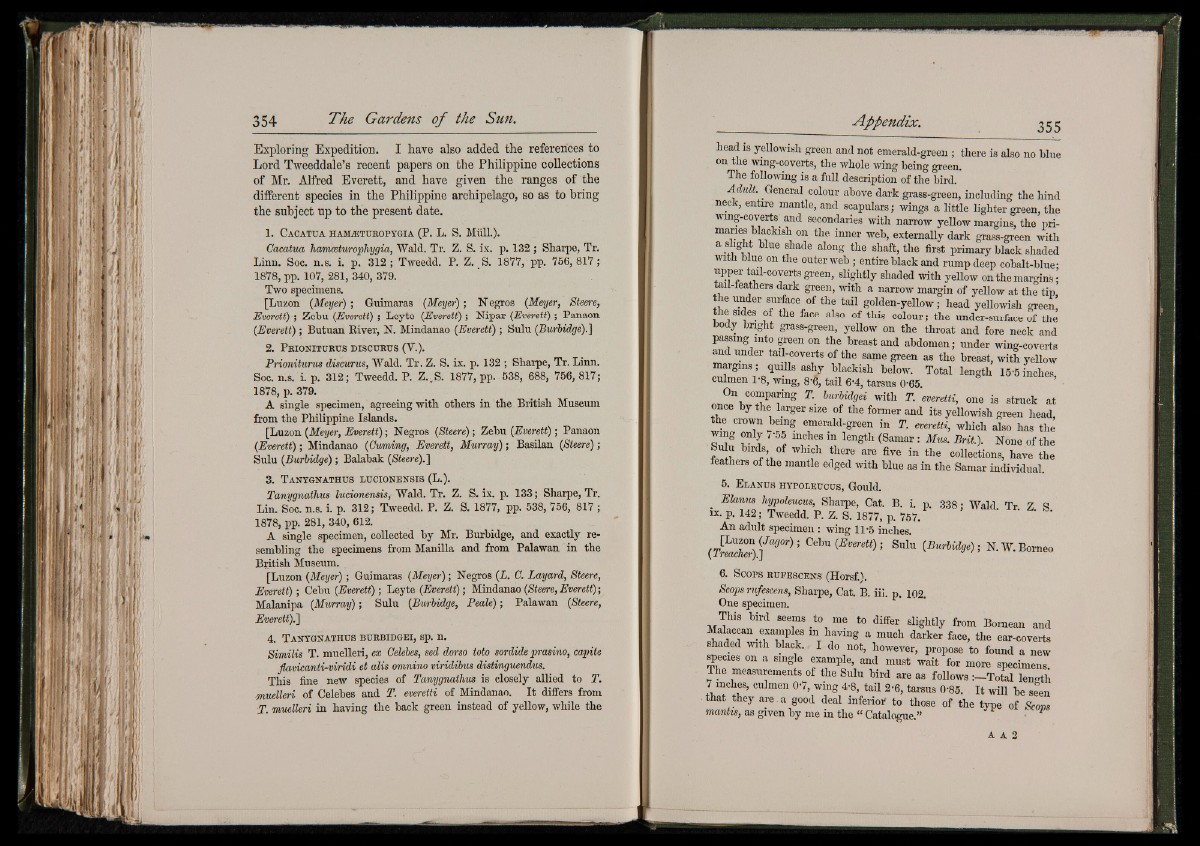
Exploring Expedition. I have also added the references to
Lord Tweeddale’s recent papers on the Philippine collections
of Mr. Alfred Everett, and have given the ranges of the
different species in the Philippine archipelago, so as to bring
the subject up to the present date.
1. C a c a t u a h a m ^ t u e o p y g ia (P. L. S. Mull.).
Gacatua hamceturophygia, Wald. Tr. Z. S. ix. p. 132 ; Sharpe, Tr.
Linn. Soc. n.s. i. p. 312; Tweedd. P. Z. S. 1877, pp. 756, 817;
1878, pp. 107, 281, 340, 379.
Two specimens.
[Luzon (Meyer) ; Guimaras (Meyer); N egros (Meyer, Steere,
Everett) -, Zebu (Everett); Leyte (Everett); Nipar (Everett); Panaon
(Everett) ; Butuan Biver, N. Mindanao (Everett) ; Sulu (Burbidge).]
2. P r io n it u r u s d is c g r u s (V.).
Prioniturus discurus, Wald. Tr. Z. S. ix. p. 132 ; Sharpe, Tr. Linn.
Soc. n.s. Lp. 312; Tweedd. P. Z.,S. 1877, pp. 538, 688, 756, 817;
1878, p. 379.
A single specimen, agreeing with others in the British Museum
from the Philippine Islands.
[Luzon (Meyer, Everett); Negros (Steere); Zebu (Everett); Panaon
(Everett); Mindanao (Cuming, Everett, Murray); Basilan (Steere);
Sulu (Burbidge) ; Balabak (Steere).)
3. T a n y g n a t h u s l u c io n e n s is (L.).
Tanygnathus lucionensis, Wald. Tr. Z. S. ix. p. 133; Sharpe, Tr.
Lin. Soc. n.s. i. p. 312; Tweedd. P. Z. S. 1877, pp. 538, 756, 817 ;
1878, pp. 281, 340, 612.
A single specimen, collected by Mr. Burbidge, and exactly resembling
the specimens from Manilla and from Palawan in the
British Museum.
[Luzon (Meyer); Guimaras (Meyer); Negros (L. C. Layard, Steere,
Everett); Cebu (Everett) ; Leyte (Everett); Mindanao (Steere, Everett);
Malanipa (Murray); Sulu (Burbidge, Peale); Palawan (Steere,
Everett).')
4 . T a n y g n a t h u s b u r b id g e i , sp. n .
Similis T. muelleri, ex Celebes, sed dorso toto sordide prasino, capite
flavicanti-viridi et alis omnino viridibus distinguendus.
This fine new species of Tanygnathus is closely allied to T.
muelleri of Celebes and T. everetti of Mindanao. It differs from
T. muelleri in having the back green instead of yellow, while the
head is yellowish green and not emerald-green; there is also no blue
on the wmg-coverts, the whole wing being green.
The following is a full description of the bird.
Adult. General colour above dark grass-green, including the hind
neck, entire mantle, and scapulars; wings a little lighter green, the
wmg-coverts' and secondaries with narrow yellow margins, the primaries
blackish on the inner web, externally dark grass-green with SIB ® e alon8 the shaft, the first primary black shaded
with blue on the outer web ; entire black and rump deep cobalt-blue;
upper tail-coyerts green, slightly shaded With yellow on the margins;
tail-feathers dark green, with a narrow margin of yellow at the tip,
the under surface of the tail golden-yellow; head yellowish green,
the sides of the face also of this colour; the under-surface of the
body bright grass-green, yellow on the throat and fore neck and
passing into green on the breast and abdomen; under wing-coverts
and under tail-coverts of the same green as the breast, with yellow
margins; quills ashy blackish below. Total length 15-5 inches
culmen 1-8, wing, 8‘6, tail 6-4, tarsus 0-65.
On comparing T. burbidgei with T. everetti, one is struck at
once by the larger size of the former and its yellowish green head,
the crown being emerald-green in T. everetti, which also has the
wing only , -55 inches in length (Samar : Mus. Brit.). None of the
ulu birds, of which there are five in the collections, have the
feathers of the mantle edged with blue as in the Samar individual.
5. E l a n u s h y p o l e u c u s , Gould.
Elanus hypoleucus, Sharpe, Cat. B. i. p. 338 • Wald Tr 7 S
is. p. 142; Tweedd. P. Z. S. 1877, p. 757.
An adult specimen : wing 11-5 inches.
(Tnachw) ’ Cdm ; Sulu (Buri^{/e) ; N. W. Borneo
6. S c o p s r u f e s c e n s (Horsf.).
Scops rufescens, Sharpe, Cat. B. iil. p. 102.
One specimen.
This bird seems to me to differ slightly from Bornean and
Malaccan examples m having a much darker face, the ear-coverts
shaded with black. I do not, however, propose to found a new
q.ecres on a sing e example and must wait for more specimens>
The measurements of the Sulu bird are as follows :—Total length
7 inches, culmen 0-7, wing 4-8, tail 2-6, tarsus 0-85. It will be seen
that they are . a good deal inferioi' to those of the type of Scons
mantis, as given by me in the “ Catalogue.” •